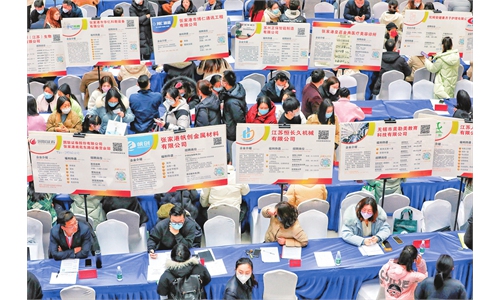
A worker assembles a truck at an auto company in Qingdao, East China's Shandong Province, on May 15, 2023. Qingdao's Jimo district has more than 400 vehicle and supporting production enterprises, covering the complete industry chain, which have injected new momentum into the development of local economy. Photo: VCG
The demographic bonus has not disappeared, and a new talent dividend is taking shape, said an official from the Ministry of Human Resource and Social Security on Wednesday, highlighting that China is still a developing country with a large population and labor force.
China's total working-age population was about 880 million as of the end of 2022, and the labor force participation rate was still high by world standards, reported the Xinhua News Agency, citing an official with the ministry.
China's basic national conditions of a large population have not changed and will not, and it is still a developing country with a large population and labor force, the ministry said.
From a structural point of view, the number of aged workers has decreased, while the number of young workers is increasing steadily.
Moreover, the quality of the population is steadily improving. In 2022, the average years of schooling for the working-age population from 16 to 59 stood at 10.9 years.
"Our demographic bonus has not disappeared, and a new talent dividend is taking shape," said the official.
China's labor productivity is improving, especially in the manufacturing sector, which has led to a higher entry level for employment but a lower demand for labor, Tian Yun, a veteran macroeconomic observer, told the Global Times on Wednesday.
It is necessary for China to increase employment in the services industries, and China has a lot of room for growth compared with developed countries such as the US, which has a more developed production services industry and a higher proportion of employment than China, Tian added.
The ministry said that it will promote youth employment, do everything possible to expand jobs, and support college graduates and other young people to show their abilities.
China will see a record 11.58 million college graduates this year, according to Xinhua.
A key meeting held on May 5 by the top decision-making body for China's financial affairs called for speeding up the construction of the country's modern industrial system backed by the real economy and advancing modernization with the support from the high-quality development of the population.
The meeting said it is necessary to strengthen the development and utilization of human resources, stabilize the labor participation rate and improve the efficiency of human resource utilization.
Local authorities across China are rolling out policies to help college graduates find jobs, and many preferential policies have been issued to help students find jobs or start their own businesses in emerging industries.
The education department of Central China's Henan Province kicked off a local 100-day sprint from May to August with specific measures to help college graduates find jobs, local media reported.
This is part of the efforts by Chinese education authorities to formulate practical policies to expand employment for graduating students this year in the face of a sluggish job market.
The campaign will focus on five tasks, including creating more jobs, improving employment guidance and strengthening assistance for key groups, according to the Ministry of Education.
A report released by Chinese job-hunting platform Zhilian Zhaopin in early May said that this year's graduates started job-hunting earlier than last year's. The ratio of those who started to seek jobs in January increased by 2.5 percentage points compared with last year and those in February climbed by 4.5 percentage points year on year.


